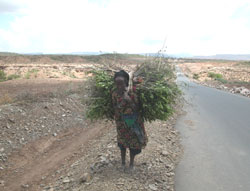Ethiopians resort to desperate measures to survive
.

A little girl searches for cactus fruit in Beklcha Biftu. Cactus fruit is only consumed by people in this area in times of severe hardship (p10311)

.
Sara Abdo Musa tries to feed her malnourished nephew
Jemale with cactus fruits, even though she knows they will cause
intestinal obstruction (p10312)

|
26 August
2003 The fruit of the “Tini” and “Hademi” cactuses that grow in West Harerghe cause severe constipation. The people here know this. But they eat them just the same. A chronic lack of food is forcing them to make use of whatever nature brings them. This morning, Sara Abdo Musa has gone scouring the hills above her village for cactus fruit. From beautiful, yellow flowers on thorny leaves, it ripens three times a year, and is just starting to come into season again. “I was guessing that I would find at least one or two, and I found five small ones,” says Sara, who tries to feed the red, stony flesh of the cactus fruit to a severely malnourished nephew. “We do not eat cactus fruit unless there is a crisis”, Sara explains. “With the food aid that we received from the Red Cross we are able to have two meals a day. Before we got the food aid, we had to eat a lot of cactus fruit, and I am sure that we will have to start eating it again as soon as it is ripe” says Nuria Omarta, a 30-year-old mother of three. No choice One of her children is four years old Adem Abdi Omar, whose feet and ankles have started to swell due to malnutrition. “The taste of the cactus fruit is not good, but we have no choice. It hurts our stomachs. The children especially suffer from eating it,” she says. Nuria has a small amount of lentils and maize left from the last round of Red Cross food distribution. Now she is waiting for the next round. “They have told us we will get food every month,” she says and looks at us with hope. However, this will depend on the response from donors around the world. Sara and Nuria’s village, Wodaye Jami, is located in the highland area of Beklcha Biftu, which means “gate of the morning moon” - a land normally blessed with fertile soil covered with a green carpet of agricultural produce, a land that usually manages to feed its inhabitants and even produce a surplus. But a lack of rain has now transformed it into an empty basket. All the families we spoke to said that they are suffering from lack of food. In the lowlands, where it is even drier and the cattle are dying, the consumption of cacti is even more widespread, according to Ethiopia Red Cross staff and volunteers who know the area well. “We have also observed that grasses and leaves which are not used much in normal years, now are being added to porridge,” says consultant nutritionist Paul Rees-Thomas from the British Red Cross. Future vulnerability
Other coping strategies being employed by the population include selling off their important possessions and reducing the number of meals per day. There has also been an increase in migration. |